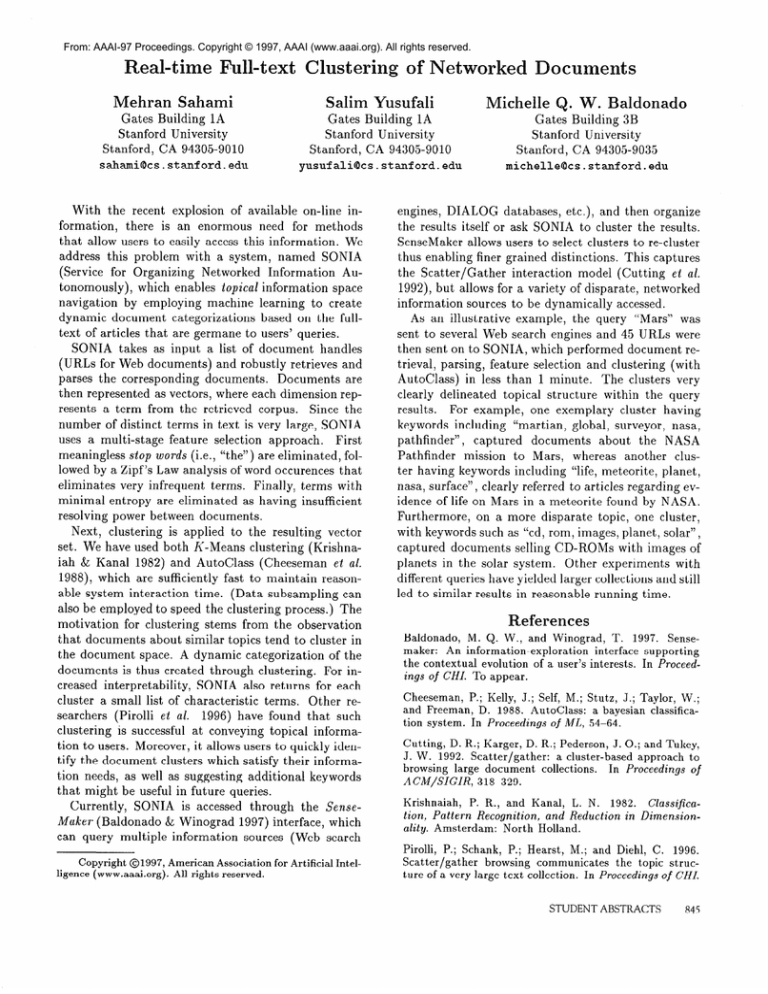
From: AAAI-97 Proceedings. Copyright © 1997, AAAI (www.aaai.org). All rights reserved.
eal-time fill-text
Mehran
Saharni
Gates Building 1A
Stanford University
Stanford, CA 94305-9010
sahami@cs.stanford.edu
Gates
Building
Stanford University
Stanford, CA 94305-9035
michelle@cs.stanford.edu
yusufali@cs.sta.nford.edu
able system interaction
time. (Data subsampling
can
also be employed to speed the clustering process.) The
motivation
for clustering stems from the observation
that documents about similar topics tend to cluster in
the document space. A dynamic categorization
of the
documents is thus created through clustering.
For increased interpretability,
SONIA also returns for each
cluster a small list of characteristic
terms.
Other researchers (Pirolli et al. 1996) have found that such
clustering is successful at conveying topical information to users. Moreover, it allows users to quickly identify the document clusters which satisfy their information needs, as well as suggesting additional keywords
that might be useful in future queries.
Currently,
SONIA is accessed through the SenseMaker (Baldonado
& Winograd 1997) interface, which
can query multiple information
sources (Web search
for Artificial Intel-
Baldcmado
1A
Stanford University
Stanford, CA 94305-9010
set. We have used both Ii-Means
clustering (Krishnaiah & Kanal 1982) and AutoClass
(Cheeseman
et al.
1988), which are sufficiently fast to maintain reason-
American Association
All rights reserved.
W.
Salim Yusufali
With the recent explosion of available on-line information,
there is an enormous
need for methods
that allow users to easily access this information.
We
address this problem with a system, named SONIA
(Service for Organizing
Networked Information
Autonomously),
which enables topicad information
space
navigation
by employing machine learning to create
dynamic document categorizations
based on the fulltext of articles that are germane to users’ queries.
SONIA takes as input a list of document handles
(URLs for Web documents) and robustly retrieves and
parses the corresponding
documents.
Documents
are
then represented as vectors, where each dimension represents a term from the retrieved corpus.
Since the
number of distinct terms in text is very large, SONIA
uses a multi-stage
feature selection approach.
First
meaningless stop words (i.e., “the”) are eliminated, followed by a Zipf’s Law analysis of word occurences that
eliminates very infrequent terms. Finally, terms with
minimal entropy are eliminated as having insufficient
resolving power between documents.
Next, clustering is applied to the resulting vector
Copyright 01997,
ligence (www.aaai.org).
of Networ
Clustering
engines, DIALOG
databases, etc.), and then organize
the results itself or ask SONIA to cluster the results.
SenseMaker allows users to select clusters to re-cluster
thus enabling finer grained distinctions.
This captures
the Scatter/Gather
interaction
model (Cutting
et al.
1992), but allows for a variety of disparate, networked
information sources to be dynamically accessed.
As an illustrative
example, the query “Mars” was
sent to several Web search engines and 45 URLs were
then sent on to SONIA, which performed document retrieval, parsing, feature selection and clustering (with
AutoClass)
in less than 1 minute.
The clusters very
clearly delineated topical structure within the query
results.
For example, one exemplary
cluster having
keywords including “martian, global, surveyor, nasa,
pathfinder”,
captured
documents
about the NASA
Pathfinder
mission to Mars, whereas another
cluster having keywords including “life, meteorite, planet,
nasa, surface”, clearly referred to articles regarding evidence of life on Mars in a meteorite found by NASA.
Furthermore,
on a more disparate topic, one cluster,
with keywords such as “cd, rom, images, planet, solar”,
captured documents selling CD-ROMs
with images of
planets in the solar system.
Other experiments
with
different queries have yielded larger collections and still
led to similar results in reasonable running time.
References
Baldonado,
M.
Q.
W.,
and Winograd,
T.
An information-exploration
interface
the contextual
evolution of a user’s interests.
ings of CHI. To appear.
maker:
1997.
Sense-
supporting
In Proceed-
Cheeseman,
P.; Kelly, J.; Self, M.; Stutz, J.; Taylor, W.;
and Freeman,
D. 1988. AutoClass:
a bayesian classification system. In Proceedings
of ML, 54-64.
Cutting, D. R.; Karger, D. R.; Pederson, J. 0.; and Tukey,
J. W. 1992. Scatter/gather:
a cluster-based
approach to
browsing large document
collections.
In Proceedings
of
A CM/SIGIR,
318-329.
Krishnaiah,
P. R., and Kanal, L. N. 1982.
CZassification, Pattern
Recognition,
and Reduction
in Dimensiona&y. Amsterdam:
North Holland.
Pirolli, P.; Schank, P.; Hearst, M.; and Diehl, C. 1996.
Scatter/gather
browsing communicates
the topic structure of a very large text collection.
In Proceedings
of CHI.
STUDENT ABSTRACTS
845







